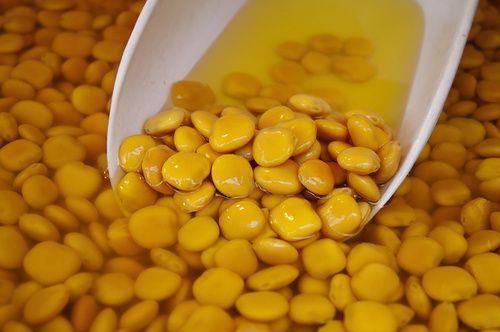I lupini are legumes that are often found at village festivals to munch on as a snack. They can be used to prepare soups and soups, why energetic and rich in nutrients, and are useful for the health of the heart and the entire cardiovascular system. Let's find out better.
> 2. Properties and benefits of lupins
> 3. Calories and nutritional values of lupins
> 4. Allies of

Description of lupins
Lupinus albus, is a legume.
Il lupine it is a plant that loves a temperate climate and grows well along the coasts of the Mediterranean. It is a legume little used in our kitchen, but, in recent years, thanks to the knowledge of its innumerable properties, it has been rediscovered and re-evaluated. It is often found in village festivals, ready to munch as a snack.
Properties and benefits of lupins
Lupine is very energetic and very protein. Contains about 40 grams of protein on 100 grams of food, an amount comparable to that of meat. Lupine is therefore a valid alternative to foods of animal origin as regards protein intake.
Lupine is highly digestible and does not contain cholesterol. It is, therefore, a highly recommended food in the prevention of cardiovascular risk. It also contains a good amount of dietary fiber and essential Omega 3 and Omega 6 fatty acids.
Lupine does not contain gluten, so it can also be consumed by those suffering from celiac disease.
Lupins are used to obtain a flour used for the preparation of pasta and various baked goods.
Calories and nutritional values of lupins
100 g of lupins contain 114 kcal / 476 kj.
Furthermore, for every 100 g of this product, we have:
- Water 69g
- G carbohydrates 7,10
- Sugars 0,50 g
- 16,40 g protein
- 2,40 g fat
- Cholesterol 0 g
- Iron 5,50 mg
- Calcium 45 mg
- Phosphorus 100 mg
- Vitamin B1 0,10 mg
- Vitamin B2 0,01 mg
- Vitamin B3 0,20 mg
Lupine, ally of
Intestine, heart, skin.
Vegetable proteins for athletes: how to supplement them with lupins, cereals and algae

Curiosities about lupins
As is well known, in I Malavoglia, the famous novel by Giovanni Verga, the episode of the bankruptcy of a "lupine shop". Perhaps not everyone knows, however, that there is a small yellow on the nature of these lupins.
In the novel, in fact, there are no elements that tell us exactly what these lupins were. In fact, it is not certain that Verga was referring to legumes as, in Sicily, certain species of molluscs, similar to clams, are called lupins.
A recipe up your sleeve
Now that we know all the properties of lupine, how do we cook it? Lupins contain a very bitter substance and, to eliminate the taste, they must be boiled and salted before consumption. After boiling them, they should be kept for at least a couple of hours in salted water.
At this point they can be toasted. Alternatively, always after having performed the "sweetening" procedure, they can be used for the preparation of soups and minestrone. Try adding them to mixed vegetable soup and you won't regret it.
The diet for menopause: lupins, whole grains and fresh vegetables
Other articles on lupines:
> Lupins to reduce cholesterol: do they work?
> Lupins at the table to fight diabetes and cholesterol
| Meteoweb


























